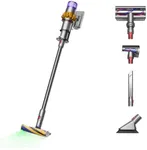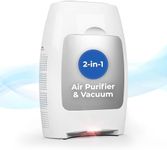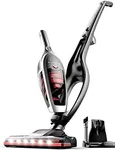Buying Guide for the Best Vacuum For Allergies
When choosing a vacuum cleaner for allergies, it's important to focus on features that can effectively capture and contain allergens such as dust, pollen, pet dander, and other microscopic particles. The right vacuum can significantly improve indoor air quality and reduce allergy symptoms. Here are the key specifications to consider when selecting a vacuum cleaner for allergies.Filtration SystemThe filtration system is crucial for trapping allergens and preventing them from being released back into the air. High-Efficiency Particulate Air (HEPA) filters are the gold standard, as they can capture 99.97% of particles as small as 0.3 microns. For allergy sufferers, a vacuum with a HEPA filter is highly recommended. Some vacuums also have additional layers of filtration, such as carbon filters, which can help with odors. When choosing, ensure the vacuum has a true HEPA filter and not just 'HEPA-like' or 'HEPA-type' filters, which are less effective.
Sealed SystemA sealed system ensures that all the air passing through the vacuum is filtered and no unfiltered air escapes. This is important because even the best filters are ineffective if the vacuum leaks air. Look for vacuums that advertise a completely sealed system, which means all the components and connections are designed to prevent air leaks. This feature is particularly important for allergy sufferers to ensure maximum allergen containment.
Suction PowerSuction power determines how effectively the vacuum can pick up dirt and allergens from various surfaces. Higher suction power is generally better, especially for deep cleaning carpets where allergens can get embedded. However, too much suction can make it difficult to vacuum delicate surfaces like curtains or upholstery. Look for vacuums with adjustable suction settings so you can customize the power based on the surface you're cleaning. For allergy sufferers, a vacuum with strong, adjustable suction is ideal to ensure thorough cleaning.
Bagged vs. BaglessBagged vacuums tend to be better for allergy sufferers because they contain dust and allergens more effectively when you empty them. Bagless vacuums can release dust and allergens back into the air when you empty the dustbin, which can be problematic for those with allergies. If you prefer a bagless vacuum, look for models with features that minimize dust exposure, such as self-sealing dustbins or easy-empty systems. For the best allergen containment, a bagged vacuum with high-quality, self-sealing bags is recommended.
Brush RollThe brush roll is the part of the vacuum that agitates carpet fibers to loosen dirt and allergens. For allergy sufferers, it's important to have a brush roll that can effectively clean carpets but also be turned off or adjusted for hard floors to prevent scattering dust. Some vacuums have tangle-free brush rolls or self-cleaning features, which can be helpful if you have pets. Choose a vacuum with a versatile brush roll that can handle different floor types and is easy to maintain.
Ease of UseEase of use includes factors like weight, maneuverability, and attachments. A lightweight and easy-to-maneuver vacuum can make cleaning less of a chore, especially if you have to carry it up and down stairs. Attachments like crevice tools, dusting brushes, and upholstery tools can help you clean hard-to-reach areas and furniture where allergens can accumulate. For allergy sufferers, a vacuum that is easy to use and comes with a variety of attachments can help ensure thorough cleaning throughout your home.
Noise LevelNoise level might not directly affect allergen removal, but a quieter vacuum can make the cleaning process more pleasant, especially if you have a sensitivity to loud noises. Vacuums with lower decibel ratings are quieter and can be less disruptive to your household. If noise is a concern, look for vacuums that are specifically designed to operate quietly without compromising on suction power and filtration efficiency.





















